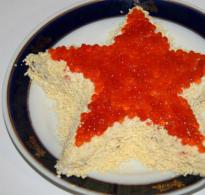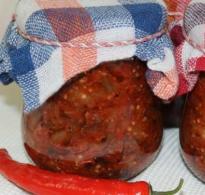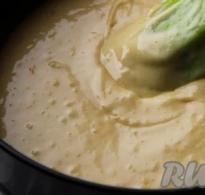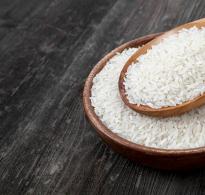Modeling a horse from salt dough. Salt dough horse
salt dough horse
For production work salt dough horses we need:
- salt dough (2 cups flour, 1 cup fine salt, not a full glass of water);
- drawing of a horse;
- rolling pin;
- thick oilcloth;
- knife;
- brush;
- needle;
- paints (gouache);
- acrylic varnish.
Salt dough horse master class.
Let's start with preparation salt dough. Take 2 cups of flour, 1 cup of fine salt, not a full glass cold water. Mix everything. As a result, the mass should become similar to plasticine: it does not crumble and does not stick to your hands (if it crumbles, add water, if it sticks to your hands, add flour).
During modeling, the dough should be kept in a plastic bag to prevent it from chaffing, and stored in the refrigerator. When the dough is ready, put it in the refrigerator for an hour. Now let's draw a horse. If that doesn’t work, you can use a printout.

Roll out the dough with a rolling pin on oilcloth a little thicker than half a centimeter.

Using the drawing, cut out the horse. Place the design on the rolled out dough and carefully cut out the outline with a knife.

Slowly remove the unnecessary dough with a knife.

Then with a needle we draw all the details (mouth, ears, nose, mane, legs, hooves). We make two balls from the salt dough, flattening them slightly - these are the eyes. Wet the mounting area with water.

We make pupils in the eyes using the back of the brush. We form an eyebrow from a small sausage. Then we make a Christmas tree from a piece of dough and attach it to the back. The horse is ready. Now let it dry. We dry it on both sides for 5 days, maybe longer. If cracks appear during drying, they will need to be covered. Place a few drops of water on the cracks, take a piece of dough and apply it on top.

We paint with gouache or acrylic paints. We paint the entire horse black, then after 2 minutes we wash it off with a sponge. Black color gives depth and volume to the horse.


Then we will paint the horse and the Christmas tree in the desired colors.

Let's make it from dough. A salt dough horse, the master class of which was provided by a master of modern hande-made works, is made in the style of a Dymkovo toy. Maybe that’s why this craft is so beautiful and attractive to the eye.
It turns out that feeling like a real creative sculptor is not so difficult at all! And you don’t need marble, granite, bronze, or even clay. After all, you can make a sculpture... out of dough! Of course it shouldn't be regular dough, and the special one is salty. Then it will not crack when drying and will acquire sufficient strength comparable to clay. Pancake flour is not suitable for creating a plastic mass, as it will definitely rise, forming cracks and deforming the figure.
How to make a salt dough horse

To make plastic salt dough you need to take flour, salt and water, in weight proportions 200:200:125. But it should be taken into account that salt is twice as dense as flour, so if you measure by volume, the proportion will be 200:100:125. 
Water should be taken cold and poured in parts into the mixture of flour and salt. When kneading, it is best to use a mixer. 
Then the dough is kneaded by hand in the same way as for baking.

If you decide to sculpt a figurine of a horse, then you can do this in three steps, starting with sculpting the body. It is best to temporarily place the rest of the mass in a plastic bag so that it does not become covered with a hard crust.

Having sculpted the head and neck, this part is fastened to the body. For stickiness, you can slightly moisten the place of fastening, and carefully smooth out the “seam” itself, hiding it.

At the very end we form the mare's tail. You can make it all the way to the ground - this will increase the figure’s support by one more point.

Finished product needs to be dried well. You can use the oven and “bake” the sculpture at 80 degrees. Or you can use a microwave - it’s safer and faster. Only in microwave oven It’s better to first use the defrost mode and hold the figure for a minute.
Then you need to check whether cracks have appeared or whether the product has lost its shape. In case of surface damage, you can “make small repairs” with the dough, first dipping it into water. This way it is easy to hide unevenness and cracks that may appear.
Then you can switch to the warm-up mode. The figurine should be removed periodically and checked for strength. When it becomes hard and dry, you can start last step making figurine toys.

This will be coloring. You can use any paint: from acrylic and oil to food and watercolor. Some may even leave the figure pure white, while others will limit themselves to just coloring the mane and tail. Or you can joke a little and remember the famous colorful Dymkovo toys.
Can you now say that the horse is made from salt dough? More likely, she galloped from a fairy tale or cartoon...

This is how easy it is to become a real sculptor, sculptor, artist - in a word, a creator.
Therefore, quickly take flour and salt and get to work, gentlemen! Create your masterpieces!
Stefanova Natalya Vladimirovna teacher of the Nikolaev boarding school of the VIII type.
Master class on testoplasty
This painting inspired me to make my work.
It turns out that feeling like a real creative sculptor is not so difficult at all! And you don’t need marble, granite, bronze, or even clay. After all, you can make a sculpture... out of dough! Of course, this should not be ordinary dough, but a special one - salty. Then it will not crack when drying and will acquire sufficient strength comparable to clay. Pancake flour is not suitable for creating a plastic mass, as it will definitely rise, forming cracks and deforming the figure.
type of work
painting, panel, drawing
master class
event
technique
drawing and painting
material
gouache, glue, natural material
You will need:
for dough: 2 tbsp. flour, 1 tbsp. salt, 1 tbsp. wallpaper glue, 1 tbsp. a spoonful of starch and approximately 180g.st. water;
drawing of a horse;
stationery knife;
thin brush;
acrylic paints or gouache;
stacks for plasticine (toothpick);
Water should be taken cold and poured in parts into the mixture of flour and salt.
Then the dough is kneaded by hand in the same way as for baking.
If you decide to sculpt a figurine of a horse, then you can do this in three steps, starting with sculpting the body. It is best to temporarily place the rest of the mass in a plastic bag so that it does not become covered with a hard crust.
1.This is the picture I created. Below I will explain all the stages of its creation.

2. I drew the outline of the animals (mare and foal) on cardboard.


4. Covered them with glass and sculpted them from salt dough (without a mane and without a tail).

5. Using a toothpick or plasticine stacks, carefully apply a relief design to the horse: hooves, eyes, nostrils, ears.
6. For a foal we make the mane and tail using a garlic press, and for an adult animal we roll out thin flagella from salt dough.


We place the board with the horses to dry on the windowsill. If the thickness of the product is 1 cm, then it needs to be dried for at least 5 days. You can also dry salt dough products in the oven at 80C for an hour or more (depending on thickness).
This is the landscape I chose for my painting.


11. For coloring, take acrylic paints or gouache and a thin brush. We will draw a brown horse.
We paint the background (yellow-brown paint), then use white paint along the relief lines and draw in the hooves and spots. We take a little orchi on a dry brush and apply a light haze, giving expressiveness to the product.


13. When the paint dries, coat the product with colorless varnish and glue it to back side crafts using Dragon glue.

15. Take the glass from the frame and glue dry grass to the bottom edge. The edge with glue will then be closed by the frame. (We glue only the bottom, and leave the upper ends of the grass free - so we can hide the horses’ legs in it)

This is how easy it is to become a real sculptor, sculptor, artist - in a word, a creator.
I wish you creative success!
To make plastic salt dough you need to take flour, salt and water in weight proportions of 200:200:125. But it should be taken into account that salt is twice as dense as flour, so if you measure by volume, the proportion will be 200:100:125. 
Water should be taken cold and poured in parts into the mixture of flour and salt. When kneading, it is best to use a mixer. 
Then the dough is kneaded by hand in the same way as for baking.

If you decide to sculpt a figurine of a horse, then you can do this in three steps, starting with sculpting the body. It is best to temporarily place the rest of the mass in a plastic bag so that it does not become covered with a hard crust.

Having sculpted the head and neck, this part is fastened to the body. For stickiness, you can slightly moisten the place of fastening, and carefully smooth out the “seam” itself, hiding it.

At the very end we form the mare's tail. You can make it all the way to the ground - this will increase the figure’s support by one more point.

The finished product must be thoroughly dried. You can use the oven and “bake” the sculpture at 80 degrees. Or you can use a microwave - it’s safer and faster. Only in a microwave oven it is better to first use the defrost mode and leave the figure for a minute.
Then you need to check whether cracks have appeared or whether the product has lost its shape. In case of surface damage, you can “make small repairs” with the dough, first dipping it into water. This way it is easy to hide unevenness and cracks that may appear.
Then you can switch to the warm-up mode. The figurine should be periodically removed and checked for strength. When it becomes hard and dry, you can begin the last step of making the figurine toy.

This will be coloring. You can use any paint: from acrylic and oil to food and watercolor. Some may even leave the figure pure white, while others will limit themselves to just coloring the mane and tail. Or you can joke a little and remember the famous colorful Dymkovo toys.
Can you now say that the horse is made from salt dough? More likely, she galloped from a fairy tale or cartoon...

This is how easy it is to become a real sculptor, sculptor, artist - in a word, a creator.

Therefore, quickly take flour and salt and get to work, gentlemen! Create your masterpieces!
2014 is approaching New Year Blue Wooden Horse and in order to attract happiness into the house, we simply need to appease our horse, whose hooves are getting closer and closer... Do you hear? She's coming towards us! Watch a master class on how to make a horse from salt dough, involve the kids in the work, it’s so exciting to sculpt all kinds of figures from this elastic, pliable, environmentally friendly material...
To make such a horseshoe with a horse from salt dough, you need to prepare the modeling dough itself, print and cut out the templates necessary for the craft (or draw them yourself, by hand :)).
Ingredients for the dough:
- Flour - 1 glass;
- Salt (preferably fine) - 0.5 cups;
- Water - 1/3 cup;
- Vegetable oil – 1 tbsp;
Mix all ingredients and stir well. The dough should be soft and elastic, not stick to your hands or crumble.

After the dough is ready, we immediately begin making the craft (If for some reason you cannot make the craft now, put the salted mass in a bag so that it does not dry out).
So, we divide the dough into 2 parts: one third is for the future horse, the rest is for the horseshoe.

Roll out both pieces of dough to the required size (depending on the size of the craft), each pancake should be about 1 cm thick.

We put the horseshoe and horse templates on top.


And carefully cut out the parts along their contour, always with a sharp knife.

After the blanks are cut, you need to slightly trim the edges. Lightly wet your hands with water and smooth out the rough edges of the craft.

We make holes along the edges of the horseshoe for hanging on the wall; they can be made into cocktail straws or something similar.
As you can see, the horseshoe is ready for baking, but the horse still needs some work.
We suggest cutting the horse's legs from threads (in in this case we used jute twine). We insert one end of the thread into a cut made in the body, and at the free ends we make hooves from dough in the shape of coins.

Give round shape hooves can be done by tracing any round object.

Next we will make the mane. Take the knitting threads and fold them in several rows (the length of the mane is as desired). As a result, you will get an “accordion” of threads. Trim one edge with scissors, and “hide” the second in the horse’s head.

To do this, make a fairly deep cut in the place of the future mane and insert the mane blank inside, lightly pressing the dough with your fingers.
We do the same with the tail. The difference is that the tail piece must be tied at the base. Then the tail will turn out beautiful and even.

Now we place our crafts on a baking sheet lined with foil and sprinkled with flour (it is advisable to wrap the horse’s mane and tail in foil). Place everything in the oven for medium heat for drying. On average, a salt dough product of this thickness takes about half an hour to dry. After this time, the products harden and acquire a ringing sound if they are tapped on a hard surface. The dough itself may brown a little, or may remain white.

And now - decor! It is no coincidence that our horse is made in white and blue (after all, 2014 is approaching - the year of the blue wooden horse). But you can turn on the flight of fancy and decorate the horse to your taste. Gouache, acrylic or oil paint is suitable for painting our product.

And now finishing touch. We select or crochet a rope and, if desired, make tassels.


If you suddenly forget to make holes in the horseshoe :), then you can attach a string for hanging using a glue gun or glue it with good universal glue.
That's all, the horseshoe with the blue horse is ready! May she bring you happiness!

Happy New Year 2014!







